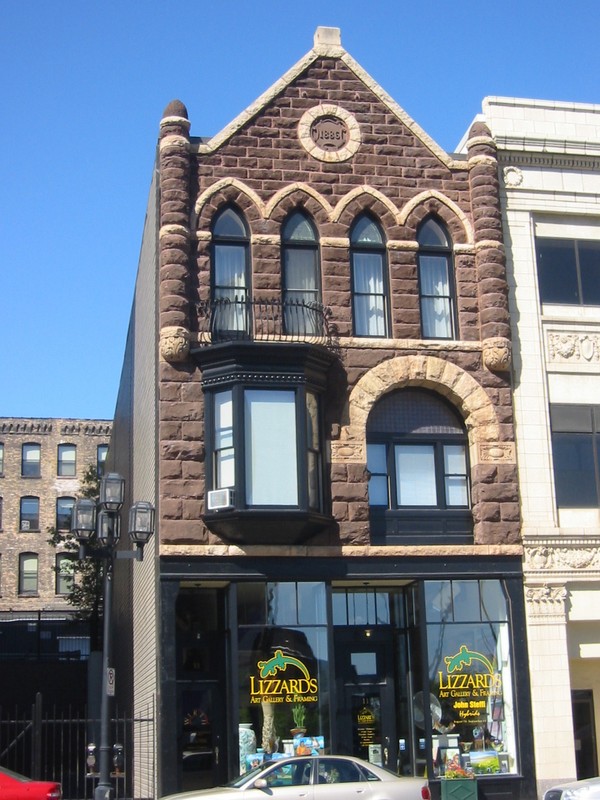Wirth Building
Introduction
Text-to-speech Audio
Images
2007 photo of the Wirth Building in Duluth

Backstory and Context
Text-to-speech Audio
The Wirth Building in Duluth exemplifies the Richardsonian Romanesque style, which made its presence felt in the Midwest during the 1880s. Oliver G. Traphagen and George Wirth, two of Duluth's most notable architects during the late nineteenth century, designed the structure; completion of construction occurred in 1885. For the first fifty years, George's brother Max owned the home where he and his family operated their pharmacy business and rented out office space. The home also supported Duluth's first female physician and was Michael Dukakis' presidential campaign headquarters in 1988.
Acclaimed architect Oliver G. Traphagen designed the Wirth Building as one of his earliest projects. O.G.Traphagen moved to Duluth in 1880 via St. Paul, Wisconsin, and New York (where he was born in 1854). Traphagen did not receive a formal education in architecture; he worked his way up from a carpenter to an architect. He worked as a carpenter for three years in Duluth before working as an independent architect from 1883 to 1885. In 1885, he joined forces with the Bavarian-born George Wirth, who, unlike Traphagen, had a formal education in architecture. Wirth came to the partnership after having already designed several buildings in Minnesota.
The two worked on the Wirth Building, named after Geroge's brother Max Wirth, who commissioned them to construct a building that would serve as a residence for him and his family and house his pharmacy business. Max Wirth and his sons operated his pharmacy business for nearly fifty-five years on the first floor while the family lived on the third floor. Max's wife, Louisa, died of cancer in 1915 at the age of 60. Max continued running the business until 1932, and his sons kept the pharmacy open until 1940. Over the years, the family rented the second floor as office space to various professionals, including Duluth's first female physician, Dr. Mary Knauf McCoy (1902 - 1910).
The Wirth family sold the home in 1950. The two top floors functioned as a boarding house while the first floor supported a dress shop, coffee shop, and then a restaurant until 1986. Presidential candidate Michael Dukakis used the lower floor as his local headquarters in 1988.
The architects' choice in 1885 to feature the Richardsonian Romanesque style did not beget a trend in Duluth. Instead, it took another five years before another Richardsonian Romanesque building arose in Duluth despite an extended building boom during the 1880s that coincided with a substantial population and economic expansion. Wirth and Traphagen separated in 1886 when Wirth returned to Bavaria. Oliver Traphagen remained in Duluth and subsequently received several notable commissions. In 1890, Traphagen again formed a partnership when he joined with the lauded architect Francis W. Fitzpatrick. The two worked together for five years and constructed several buildings in Duluth that routinely drew inspiration from the Romanesque Revival architectural style; numerous buildings exist on the National Register of Historic Places. Traphagen moved to Honolulu in the late 1890s where he again designed buildings that are now national landmarks, followed by a move to San Francisco in 1906 where he spent his retirement.
Sources
"George Wirth." Zenith City Press. zenithcity.com. Accessed August 10, 2020. http://zenithcity.com/archive/people-biography/george-wirth/.
Koop, Michael and Chris Morris "Nomination Form: Duluth Historic Commercial District." National Register of Historic Places. nps.gov. April 8, 2008. https://npgallery.nps.gov/GetAsset/0662fbe9-886c-4421-8358-075d55a1e95f.
"Oliver G. Traphagen." Zenith City Press. zenithcity.com. Accessed August 10, 2020. http://zenithcity.com/archive/people-biography/oliver-g-traphagen/.
Turbes, Larry M. "Nomination Form: Wirth Building." National Register of Historic Places. nps.gov. July 25, 1991. https://npgallery.nps.gov/GetAsset/32274150-7e9b-4eff-9b56-f0ac3b26f5ba/.
"Wirth Block." Zenith City Press. zenithcity.com. Accessed August 10, 2020. http://zenithcity.com/archive/historic-architecture/wirth-block/.
By Elkman - Own work, CC BY-SA 3.0, https://commons.wikimedia.org/w/index.php?curid=4829013
